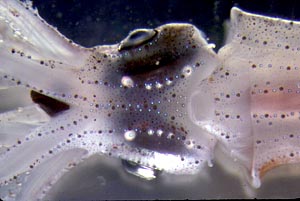Photophores are found in virtually every conceivable place if we consider all squids together. There are a few locations and densities that are obvious and/or of common occurrence that makes them useful in identification keys. These are: ocular photophores; abundant mantle (head and arms also); visceral photophores, funnel photophores; tentacular photophores.
Ocular photophores
Ocular photophores are located on the ventral surface of the eyeball. The photograph on the right shows several different types of photophores (round, iridescent; elongate, yellowish; small, white) on this extruded eyeball. Several other types of ocular photophores are seen in the photographs that follow. The arrow points out an embedded tentacular photophore.


Figure. Ventral view of the eyeball of Pterygioteuthis microlampas (Fam. Pyroteuthidae). Photograph by R. Young.
Abundant mantle photophores
Abundant photophores that are found in the skin of the mantle (as well as the head and arms) are seen in the two adjacent photographs. In the upper photograph, the photophores are located in longitudinal series, although this is not the case in all species in the family. Some are dark with a reddish hint while others are smaller with a white or bluish tint. The large white photophores on the head actually lie on the surface of the eyeball and are ocular photophores. In the lower picture the photophores are larger and not arranged in distinct longitudinal series except on the arms.



Figure. Left - Abraliopsis sp (Fam. Enoploteuthidae). Right - Stigmatoteuthis hoylei (Fam. Histioteuthidae). Photographs by R. Young.
Funnel photophores
Only a few families have squid with photophores on the funnel. The squid in the photograph to the left above (Abraliopsis sp.) has photophores on the funnel as well as the mantle, head and arms. However photophores are lacking from the funnel in the squid in the lower picture.
Visceral photophores
Visceral photophores are located inside the mantle cavity adjacent to the viscera. In these photographs, the mantle has either been cut away to expose the photophores (two pictures on right) or the mantle is transparent enough that the photophore can be seen through the mantle wall (below). The arrows point to most of the visceral photophores seen. The appearance of visceral photophores is highly variable in other families. Note also, squid in two of the photographs have white ocular photophores.




Figure. Left - Chiroteuthis spoeli (Fam. Chiroteuthidae). Middle - Chtenopteryx sp. (Fam. Chtenopterygidae). Bottom - Pterygioteuthis microlampas (Fam. Pyroteuthidae). Photographs by R. Young.
Tentacular photophores
Tentacular photophores can lie on the surface of the tentacle or within the musculature of the tentacle. In the latter case, they are not always obvious in preserved squid.




 Go to quick links
Go to quick search
Go to navigation for this section of the ToL site
Go to detailed links for the ToL site
Go to quick links
Go to quick search
Go to navigation for this section of the ToL site
Go to detailed links for the ToL site